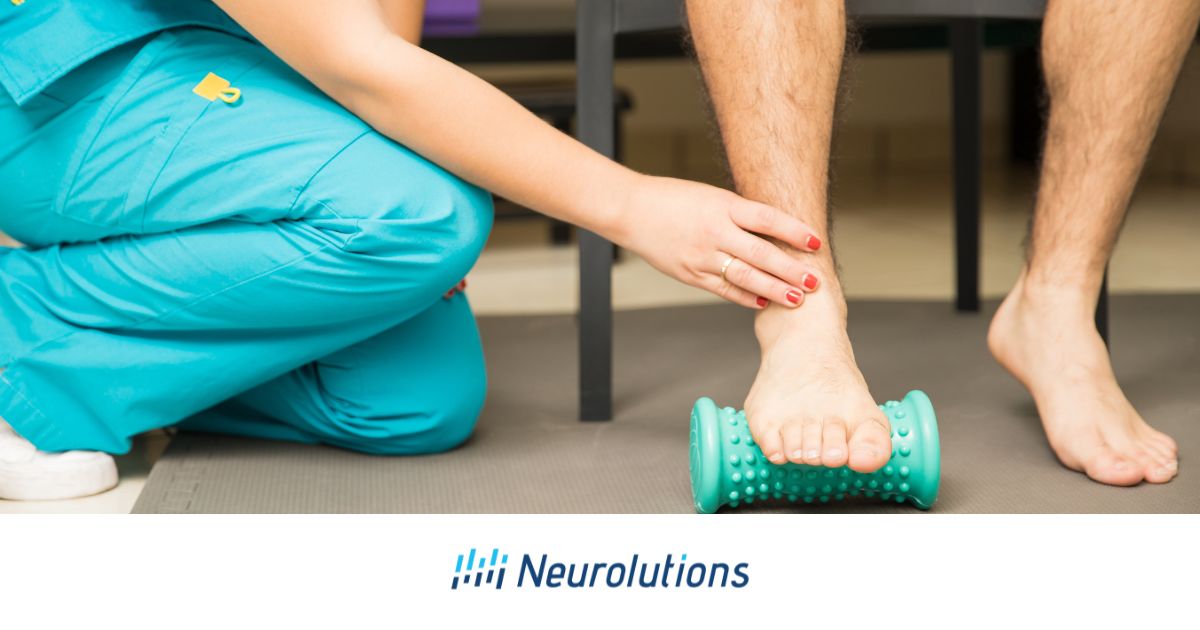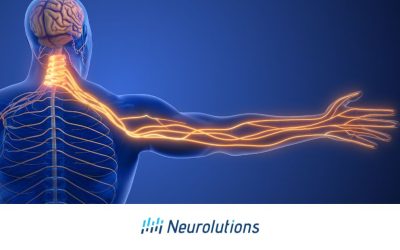What Is Claw Toe and How Does It Affect Stroke and TBI Survivors?
Claw Toe is a condition where the toes curl in a claw-like shape, often caused by a stroke or brain injury, and can lead to difficulties walking.
After a person experiences a stroke or Traumatic Brain Injury (TBI), they might encounter various physical challenges that affect their feet and toes. One such challenge is “toe flexion deformity” or “digital flexor spasticity,” where the toes curl downward, often referred to as Claw Toe in layman’s terms. This condition occurs due to muscle imbalances or spasticity, leading the toes to curl into a claw-like shape. If foot or toe movement is impacted, it can significantly increase the risk of permanently losing the ability to walk, making early intervention crucial to prevent lasting mobility issues.
Researchers have shown that 46% of stroke patients develop Claw Toe soon after their stroke (1). The following article will describe the complications surrounding Claw Toe and specific strategies that stroke survivors can practice to manage this condition.
Curled Toes After Stroke or Brain Injury: Causes and Effects
Brain injuries can affect the signals sent to muscles, causing weakness or paralysis, which can lead to curled toes like Claw Toe.
After a stroke or brain injury, the ways that the brain communicates with the muscles in the body can be affected. Normally, the brain sends signals through the spinal cord to the Peripheral Nervous System (PNS), which controls how the muscles move, including those in the feet and toes. If this communication is disrupted because of the injury, it can cause muscles to become weak or even paralyzed.
This paralysis or weakness can sometimes improve over time through cortical plasticity, or the growth of new nerve pathways in the brain, as well as through occupational and/or physical therapy (OT and/or PT).
Temporary versus Permanent Toe Curling
Toe curling happens when the muscles in the feet and toes have difficulty working properly due to brain damage. This curling can be temporary or permanent. Temporary curling, also known as “flexible,” can usually be treated and managed. However, permanent curling, also known as “rigid,” presents more persistent challenges and requires specialized treatment approaches to address the muscle contractures and restore as much mobility as possible (2).
It is important to note that while some stroke and TBI survivors experience permanent toe curling immediately after the brain injury happens, others may develop it over time.
Types of Curled Toe Disorders: Claw Toe, Hammer Toe, and Mallet Toe
Curled toes are categorized into three main types: Claw Toe, Hammer Toe, and Mallet Toe, each involving different joints and toe positions.
Each toe, with the exception of the big toe, has three joints: the metatarsophalangeal (MTP), proximal interphalangeal (PIP), and distal interphalangeal (DIP) joints (3). These joints play two essential roles: they support the body’s weight when standing and facilitate movement when walking, skipping, or running (4).
Communication pathways that are disrupted after a brain injury can cause muscles to become weak or even paralyzed. When the muscles in the foot are affected or tightened, this can also affect the toe joints.
The tightening can lead to different types of toe-curling disorders. The three main curled toe disorders are Claw Toe, Hammer Toe, and Mallet Toe:
- Hammer Toe: Typically affecting the second toe, it bends downward due to muscle weakness or paralysis. The second toe bends downward usually due to paralysis or weakness of the foot muscles.
- Claw Toe: The middle joints of any or all of the four smaller toes bend downward, causing the tips to curl upward.
- Mallet Toe: A bend occurs in the joint closest to the toenail, causing the tip of the toe to curl downward.
Symptoms of Curled Toe Disorders and How They Affect Walking
Curled toe conditions can cause pain, sores, and difficulty walking, and if left untreated, they may cause complications such as arthritis.
Living with a curled toe disorder such as Claw Toe can make wearing shoes uncomfortable and even painful because the condition often causes excessive rubbing or pressure when wearing shoes or walking. Stroke or TBI survivors with a curled toe disorder may experience several symptoms including:
- Cramps in the foot while at rest or when walking
- Open sores or ulcers on the toes due to pressure from shoes
- Difficulty walking
Pressure sores or ulcers on the toes are a significant complication of untreated curled toe disorders. Curled toes often cause abnormal walking patterns, which can impact the ankle joint and potentially lead to, or worsen, arthritis in the ankle. Therefore, untreated curled toe disorders can reduce a person’s ability to move, further impacting their overall health.
Claw Toe vs Hammer Toe vs Mallet Toe: Key Differences and Risks
Claw Toe is often related to problems caused by conditions like stroke, TBI, or diabetes, and requires early treatment to prevent stiffness.
Unlike Hammer Toe and Mallet Toe, Claw Toe is more often connected to nerve problems rather than just wearing tight shoes or having arthritis. People who have had a stroke or a TBI often develop Claw Toe due to the tightening of their foot muscles, which can create a high arch and cause the toes to curl into a claw-like shape.(5).
Additionally, people with Type-2 diabetes, especially those with Peripheral Neuropathy, often develop Claw Toe. Individuals with Multiple Sclerosis (MS), Cerebral Palsy, and Parkinson’s Disease are also at increased risk for developing Claw Toe. Regardless of what the underlying cause may be, it is best to implement treatment as early as possible to try to stop the muscles around the toe joints from becoming permanently tight or stiff.
For stroke and TBI survivors with Claw Toe, OT and/or PT typically begins early with passive “range of motion” exercises. The therapist can gently move and massage the foot and toes to stimulate the muscles before the patient is able to regain movement on their own. Once some movement is restored, the patient can start practicing active exercises, performing toe, foot, and leg movements independently. This rehabilitation strategy is employed to prevent Claw Toe from becoming permanent, and it also helps the patient relearn how to stand and walk.
Treatment Approaches for Curled Toes – “Flexible” versus “Rigid” Claw Toe
Treatment for curled toes depends on whether the condition is flexible or rigid.
The treatment for curled toes, such as Claw Toe, differs depending upon whether the condition is temporary (“flexible”) or permanent (“rigid”). The approach also depends on the specific type of curled toe disorder. Below are treatment suggestions for temporary curled toes (6):
- Roomy Footwear: Always wear shoes that are spacious enough to allow for correct foot placement when standing or walking.
- Custom Orthotics: Use custom orthotics and/or individually-designed pads in footwear to support correct foot and toe alignment.
- Daily Exercises: Perform daily exercises to reverse the Claw Toe or other curled toe condition.
- Splints or Taping: Wear a splint or add tape to toes to maintain the correct position.
- Physical Therapy: Attend OT and/or PT sessions aimed at achieving correct foot and toe positioning when standing and walking.
One simple exercise to practice daily is to gently stretch each toe into the correct position and hold it for a few seconds. Another exercise is to try picking up marbles or a towel from the floor using the toes (7).
How to Manage and Treat Permanent Claw Toe
For rigid, permanent curled toes, custom shoes and splints are often necessary, with surgery as a last resort if other treatments are not successful.
If someone is diagnosed with Claw Toe or another curled toe condition that is “rigid,” they may need specialized or custom shoes. These shoes should help reduce pressure on the curled toes and encourage proper walking. In some cases, using splints or taping the toes might be needed. Treatment options are usually divided into non-surgical and surgical methods, with surgery being a last resort if non-surgical treatments don’t work.
Non-Surgical Treatments
Medications and Functional Electrical Stimulation (FES)
The following are options that can be used to treat Claw Toe:
- NSAIDs: Over-the-counter Nonsteroidal Anti-Inflammatory Drugs are commonly used to manage pain associated with curled toes (8).
- Botulinum Toxin (BoNT) Injections: Some patients benefit from these injections to treat Claw Toe (9-10).
- Cortisone Injections: These can provide temporary relief from curled toe symptoms (11).
- Hyaluronic Acid Injections: These can also be used to alleviate symptoms (12).
- Functional Electrical Stimulation (FES): FES is used to treat curled big toes and reduce muscle tightness in the arms and legs (13).
Surgery for Curled Toe Disorders
Surgery is generally recommended if a person experiences significant pain alongside a permanent or “rigid” Claw Toe disorder. The procedures for Claw Toe, Hammer Toe, and Mallet Toe differ, but can often be performed in a single operation to minimize the need for multiple surgeries. The following are common surgical options to treat Claw Toe (14):
- Tendon Lengthening and Re-routing: adjusting the tendons to help straighten the toes
- Temporary Steel Pin Insertion: inserting a pin to hold the toe in the correct position
- Bone Shortening: reducing the length of one or more toe bones to alleviate pressure and improve alignment
- Bone Fusion: fusing the bones on either side of a toe joint to permanently correct the curl
Post Surgery Care
After surgery, various non-surgical treatment options such as splinting, FES, and specially-designed shoes for walking are typically used to improve outcomes. Several weeks of OT and/or PT are crucial for improving recovery and restoring mobility.
How to Manage Painful Cramps from Claw Toe and Curled Toe Disorders
To manage cramps caused by Claw Toe or other curled toe conditions, treatments include rest, ice, and medications like NSAIDs.
Cramps in the toes and feet are very common for people with curled toe conditions like Claw Foot. People can employ several strategies to manage these cramps, such as applying ice, resting the foot, and taking oral NSAID medications. Since OT and/or PT focus on correcting walking positions to prevent falls and toe curling disorders, they can sometimes lead to painful toe cramps. It’s important to manage these cramps both during and after therapy.
Foot Drop and Toe Cramps or Pain:
Foot drop refers to having challenges lifting the front part of the foot, a condition frequently seen in people who have experienced a stroke, TBI, or neurological disorder.
The inability to walk normally due to foot drop can increase the likelihood of developing curled toes and associated cramps. Therefore, OT and/or PT to promote proper walking posture is a major part of post-stroke or TBI rehabilitation for those who may be able to walk independently but struggle with correct foot placement. Managing foot cramps is just as important as managing toe cramps to ensure correct foot placement while walking.
Long-Term Management and Recovery from Claw Toe Disorders
Long-term management, including therapy and proper footwear, is important to prevent curled toes from returning or getting worse.
Recovery from curled toe disorders depends on the duration and severity of the condition. Long-term management is necessary to prevent the condition from reoccurring. Following the instructions of health care providers is vital to avoid the return of the curled toe disorder. For individuals with permanently curled toes, wearing specialized shoes that support proper walking is essential to prevent the condition from worsening or the emergence of new curled toe problems. Once a person has experienced a curled toe disorder, the likelihood of it reoccurring is higher.
Claw Toe and Foot Drop: Improving Mobility and Quality of Life After Stroke
Claw Toe can severely impact walking and quality of life, but with proper treatment and support, many people can regain mobility and independence.
Curled toe disorders such as Claw Toe can significantly impact a person’s ability to walk, especially for stroke and TBI survivors who have experienced foot paralysis or weakness due to their brain injury. Neurological disorders can increase the likelihood of developing foot drop, which can further impair walking and contribute to the development of Claw Toe.
Living with foot drop or Claw Toe increases the risk of poor balance and a decreased walking ability. Both conditions require long-term management and treatment. Non-surgical treatments may be sufficient for some, while others may require surgery.
No matter which treatment is chosen, it’s important to aim for an outcome that helps individuals walk as normally as possible. Being able to walk and do everyday activities on their own can greatly improve the quality of life for survivors of stroke and TBI. With the right support and treatment, many people can achieve this goal and enjoy a more active and fulfilling life.
References:
- Laurent G, Valentini F, Loiseau K, et al. (2010). Claw toes in hemiplegic patients after stroke. Annals of Physical and Rehabilitative Medicine 53(2): 77-85. Webpage: https://pubmed.ncbi.nlm.nih.gov/20097630/
- American Stroke Association. Claw Toe. Webpage: https://www.stroke.org/en/about-stroke/effects-of-stroke/physical-effects-of-stroke/physical-impact/claw-toe
- Manganaro D, Dollinger B, Nezwek TA, et al. (Updated 2023). Anatomy, Bony Pelvis and Lower Limb, Foot Joints. In: StatPearls [Internet]. StatPearls Publishing: Treasure Island, FL. Webpage: https://www.ncbi.nlm.nih.gov/books/NBK536941/
- Arthritis Foundation. Anatomy of the Foot. Webpage: https://www.stroke.org/en/about-stroke/effects-of-stroke/physical-effects-of-stroke/physical-impact/claw-toe
- Seaman TJ, and Ball TA. (Updated 2023). Pes Cavus. In: StatPearls [Internet]. In: StatPearls [Internet]. StatPearls Publishing: Treasure Island, FL. Webpage: https://www.ncbi.nlm.nih.gov/books/NBK556016/
- Cleveland Clinic [Cleveland, OH]. Claw Toes. Webpage: https://my.clevelandclinic.org/health/diseases/16875-claw-toes
- American Academy of Orthopedic Surgeons (AAOS), OrthoInfo. Diseases and Conditions: Claw Toe. Webpage: https://orthoinfo.aaos.org/en/diseases–conditions/claw-toe/
- UK Healthcare [University of Kentucky, Lexington, KY]. Hammer, Claw, and Mallet Toe. Webpage: https://ukhealthcare.uky.edu/orthopaedic-surgery-sports-medicine/conditions/general-orthopaedics/hammer-claw-mallet-toe
- Lim EC, Ong BK, and Seet RC. (2006). Botulinum toxin-A injections for spastic toe clawing. Parkinsonism and Related Disorders 12(1): 43-47. Webpage: https://pubmed.ncbi.nlm.nih.gov/16198612/#:~:text=Injecting%20BTX%2DA%20to%20the,lower%20dosages%20to%20be%20used.
- Takekawa T, Hara T, Yamada N, et al. (2023). Treatment outcome of local injection of botulinum toxin for claw toe: Differences between cerebral hemorrhage and infarction. Clinical Neurology and Neurosurgery 226: 107620. Webpage: https://pubmed.ncbi.nlm.nih.gov/36805253/
- Malhotra K, Davda K, and Singh D. (2016). The pathology and management of lesser toe deformities. EFORT Open Reviews 1(11): 409-419. Webpage: https://www.ncbi.nlm.nih.gov/pmc/articles/PMC5367573/
- Dang DY, and Coughlin MJ. (2020). Mallet Toes, Hammertoes, Neuromas, and Metatarsophalangeal Joint Instability: 40 Years of Development in Forefoot Surgery. Indian Journal of Orthopaedics 54(1): 3-13. Webpage: https://www.ncbi.nlm.nih.gov/pmc/articles/PMC7065734/
- Takekawa T, Takagi S, Kitajima T, et al. (2022). Claw Toe: Anatomic Guide for Injection of Botulinum Toxin into Foot Muscles. Canadian Journal of Neurological Sciences 49(1): 102-108. Webpage: https://www.cambridge.org/core/journals/canadian-journal-of-neurological-sciences/article/claw-toe-anatomic-guide-for-injection-of-botulinum-toxin-into-foot-muscles/9A9374A040091AB2AC0322BB6396DF42
- Cleveland Clinic [Cleveland, OH]. Claw Toes. Webpage: https://my.clevelandclinic.org/health/diseases/16875-claw-toes





